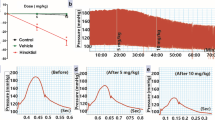Summary
This paper reviews the evidence that the antihypertensive effect of urapidil is due to a systemic vasodilatation with no change in cardiac output, no tachycardia and no under-perfusion of vital organs. Urapidil does not impair the cardiovascular control exerted by arterial baroreceptors and cardiopulmonary receptors. This is probably the reason why no orthostatic hypotension and derangement in blood pressure homeostasis follows its administration.
Similar content being viewed by others
References
De Leeuw PW, van Es PN, de Bruyn HAM, Birkenhager WH. Renal haemodynamics and neurohumoral responses to urapidil in hypertensive man. Drugs 35 (Suppl. 6): 74–77, 1988
Grassi G, Giannattasio C, Saino A, Sabadini E, Capozi A, et al. Cardiopulmonary receptor modulation of plasma renin activity in normotensive and hypertensive subjects. Hypertension 11:92–99, 1988a
Grassi G, Parati G, Pomidossi G, Giannattasio G, Casadei R, et al. Neural control of circulation before and after intravenous urapidil in essential hypertension. Drugs 35 (Suppl. 6): 104–110, 1988b
Leonetti G, Terzoli L, Zanchetti A. Systemic haemodynamic and humoral changes during urapidil treatment in hypertensive patients. Journal of Hypertension 6 (Suppl. 2): S25–S29, 1988
Liebaú H, Solleder P, Wurst W. Long-term antihypertensive treatment with urapidil. Current Opinion in Cardiology 4 (Suppl. 4): S57–S62, 1989
Mancia G, Mark AL. Arterial baroreflexes in humans. In Shepherd et al. (Eds) Handbook of physiology: the cardiovascular system 3, section II, pp. 755–793, American Physiological Society, Bethesda, Maryland, 1983
Mark AL, Mancia G. Cardiopulmonary baroreflexes in humans. In Shepherd et al. (Eds) Handbook of physiology: the cardiovascular system 3, section II, pp. 795–815, American Physiological Society, Bethesda, Maryland, 1983
Messerli FH, Kobrin I, Amodeo C, Ventura HO, Frolich ED. Immediate cardiovascular effects of urapidil in essential hypertension. In Amery A (Ed.) Treatment of hypertension with urapidil, pp. 87–91, Royal Society of Medicine Services, London, 1986
Prichard BNC, Tomlinson B. Clinical pharmacology of drugs acting on the sympathetic nervous system. Current Opinion in Cardiology 4 (Suppl. 4): S13–S22, 1989
Takeda T, Kaneko Y, Shionoiri H, Yasuda H, Iimura O, et al. Urapidil in patients with severe hypertension and in long treatment. Journal of Hypertension 6 (Suppl. 2): S37–S42, 1988
Van Zwieten PA. Basic pharmacology of alpha-adrenoceptor antagonists and hybrid drugs. Journal of Hypertension 6 (Suppl. 2): S3–S11, 1988
Veniero A, Condorelli M. Effects of one year of antihypertensive treatment with urapidil on left ventricular hemodynamics and anatomy. In Amery A (Ed.) Treatment of hypertension with urapidil, pp. 101–110, Royal Society of Medicine Services, London, 1986
Author information
Authors and Affiliations
Rights and permissions
About this article
Cite this article
Mancia, G. Haemodynamic Effects of the Multiple Action Antihypertensive Drug Urapidil. Drugs 40 (Suppl 4), 14–20 (1990). https://doi.org/10.2165/00003495-199000404-00005
Published:
Issue Date:
DOI: https://doi.org/10.2165/00003495-199000404-00005




